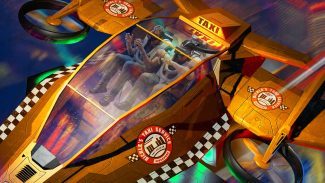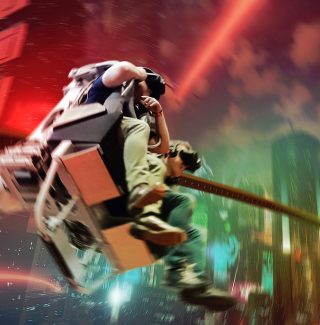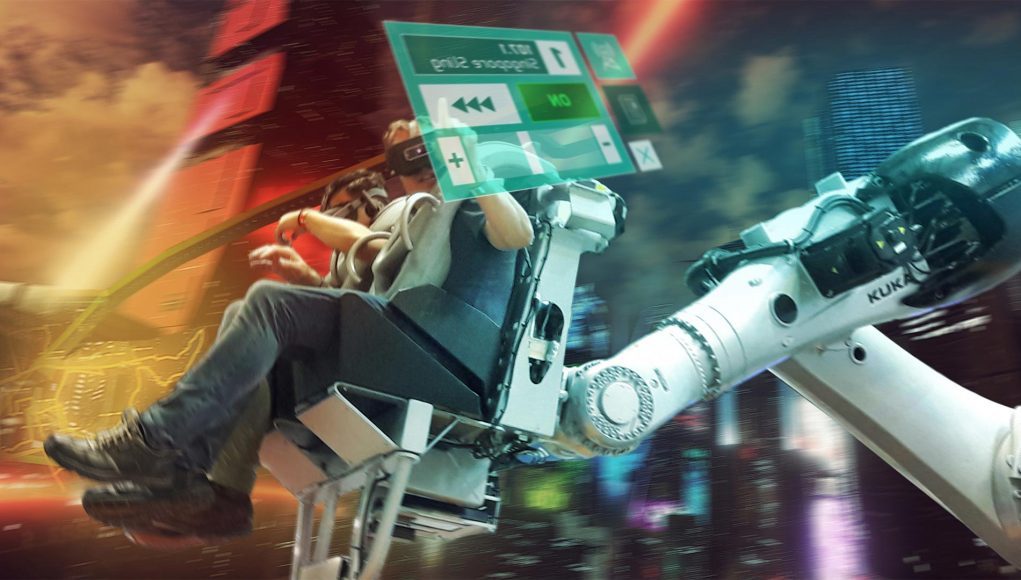First demonstrated to theme park executives at the Asian Attractions Expo in Singapore last month, Holovis’ R3ex (Rideable Realtime Robot Experiences) project combines virtual reality with four/six-axis robot arm amusement rides. The technology claims to offer the rider genuine interactivity and ‘complete agency’ over the experience, including real-time control of the motion profile.
Theme parks have been eager to add virtual reality rides to their list of attractions, but the majority of experiences are repurposed existing roller coasters, essentially offering the same ride but with a virtual environment to look at. Some have begun to offer a degree of interactivity based on where you look, but there’s only so much you can achieve with a fixed track. Being able to influence the ride in a meaningful way sounds much more compelling, and that’s what Holovis hopes to deliver with R3ex.
The debut system in the video above uses a two-seat, six-axis robot arm from KUKA, one of the leading suppliers of industrial robots. This ‘new generation’ KUKA Coaster was revealed at the end of 2015, but KUKA has been active in the entertainment sector for well over a decade; their ‘robocoaster’ arms have been in service at Legoland parks since 2003. Holovis is keen to point out that this is more than repurposing an existing ride.
“Anyone could put a VR headset on the end of a robotic arm, but it is our proprietary Interact software that makes this experience successful”, says Stuart Hetherington, CEO of Holovis. “The real-time VR world needs to synchronise perfectly with the motion and gesture interactivity, so we’ve developed specialist software to achieve this. The movements that our solution can achieve coupled with the immersive VR world take experiences of this nature to a new dimension, previously only dreamed about in science fiction.”

The demonstration depicts a futuristic flying taxi ride through Singapore. Holovis’ press release describes some of its interactivity achieved via hand tracking – “riders could explore things in the cab, such as change the radio station, scroll through the news and pick up elements that fall from the glove box as it opens during the first inversion”. It seems that in this case, the interactivity was largely limited to ‘secondary’ cockpit controls, with the motion following a selection of scripted sequences based on decisions made by the riders, but Holovis assures me that “it is possible to have direct control of the motion profile of the robot”. I asked how this might work with multiple people, and the team explained that this depends on how the particular story works. “People can be given complete control of the robot but you might not want someone else controlling your whole motion experience for the whole (ride), so the control can be switched as part of the storyline between riders so you all got a turn”.
The final version, available from November, will seat four riders at once to cater for high-capacity throughput, so it will be interesting to see how the controls can be shared in a creative and entertaining way. Of course, the beauty of real-time VR rendering combined with a multi-axis robot arm means that its potential applications are almost endless and can be improved over time; initially designed for the attractions industry, the same software can be used to safely simulate high-risk scenarios for training purposes. Holovis is developing such a simulation with a partner in Malaysia to be revealed later this year “as part of a much larger immersive training and simulation facility”. The first entertainment installation is also expected at the end of the year in Dubai.

With real agency, potential skill elements, and the need to engage four riders, you’d expect a longer seat time than a typical blink-and-you-miss-it roller coaster. Holovis says that they’re aiming at a ride/game time of between 3 and 5 minutes, “depending on the design, IP and the required capacity throughput”. They’re also developing ‘R3ex Arena’ solutions with multiple robots, and thanks to the company’s expertise in mixed reality, are promising a “unique onboard and offboard solution that allows the guests in the queue to game using BYOD/smartphones and AR technology”.
Leap Motion units attached to the headsets perform hand tracking duties, which Holovis say is ‘very stable’ despite the wild ride – “we developed a specific software interface to handle the synchronisation of the Leap data with our motion positioning and control systems to ensure perfect real-time interaction with correct positional referencing of the hands”.
Combining motion technology, interactivity and high-quality visuals means greater performance requirements than the mobile VR solutions (regularly used on VR roller coasters) can handle – in the first demonstration R3ex is rendering on a PC using Oculus Rift headsets (without the IR cameras as players are tightly strapped in, meaning that positional tracking is unnecessary) – but Holovis say they are hardware agnostic and “can work with whichever platform is right for the application”.
The graphics, story integration to the motion profile and the gesture interactivity were all created in-house for their proprietary Interact system. Holovis have developed ‘all the elements’ in R3ex, with a team of over 100 people based in the UK, US and China, working closely with KUKA to ensure that both pre-programmed motion profiles as well as real-time guest controlled motion are delivered safely.
Promising “new levels of interactivity, graphical quality and sustained physical forces on the rider”, this type of ride has the potential to be a more suitable pairing (compared to a roller coaster) for VR at theme parks and other attractions.







